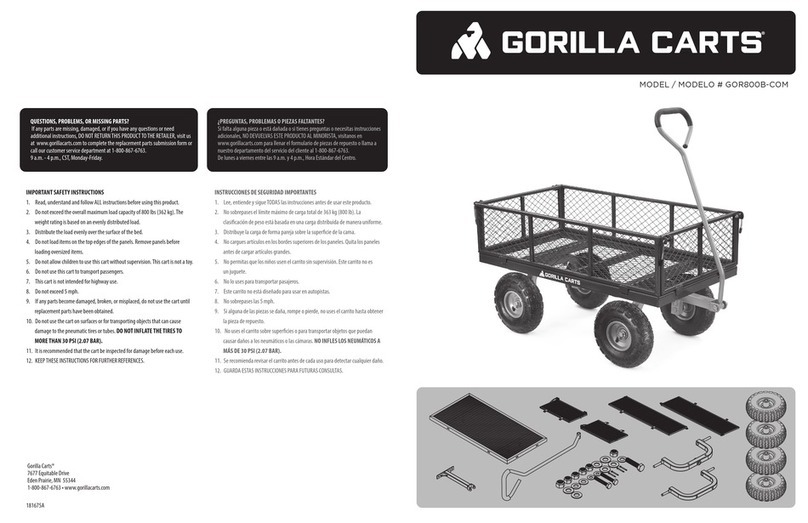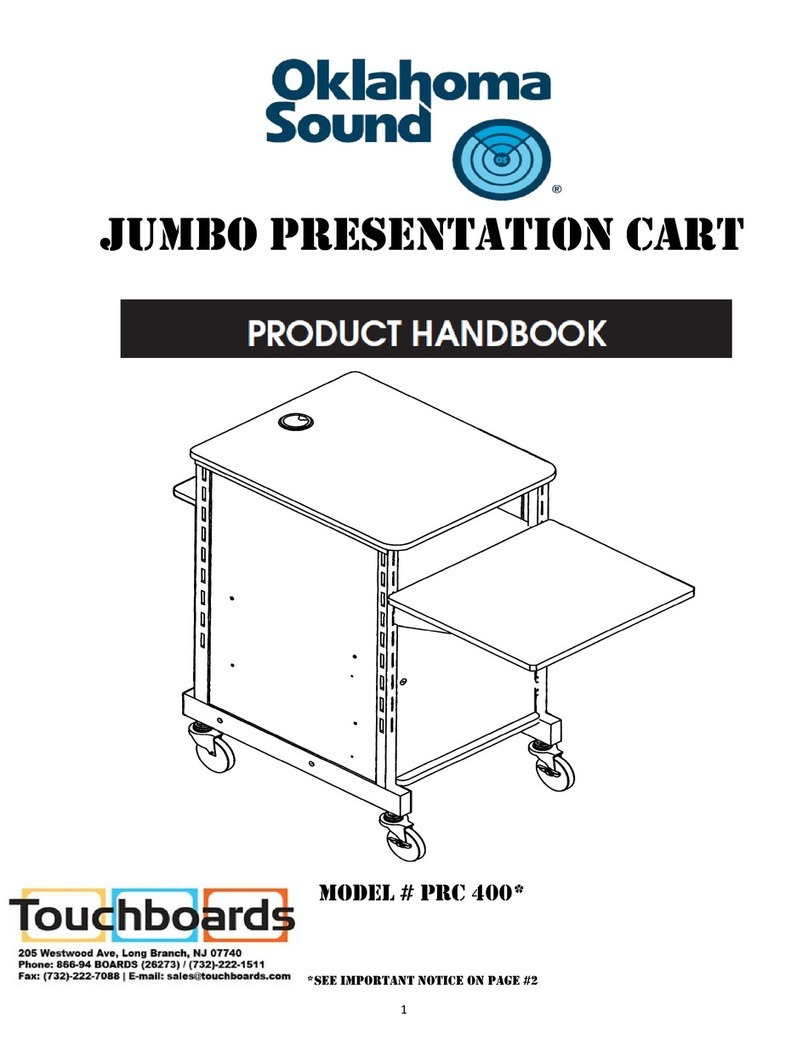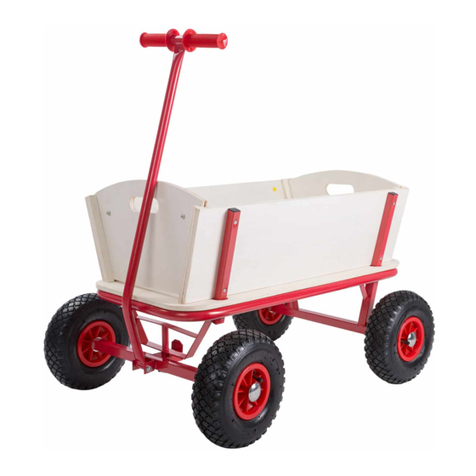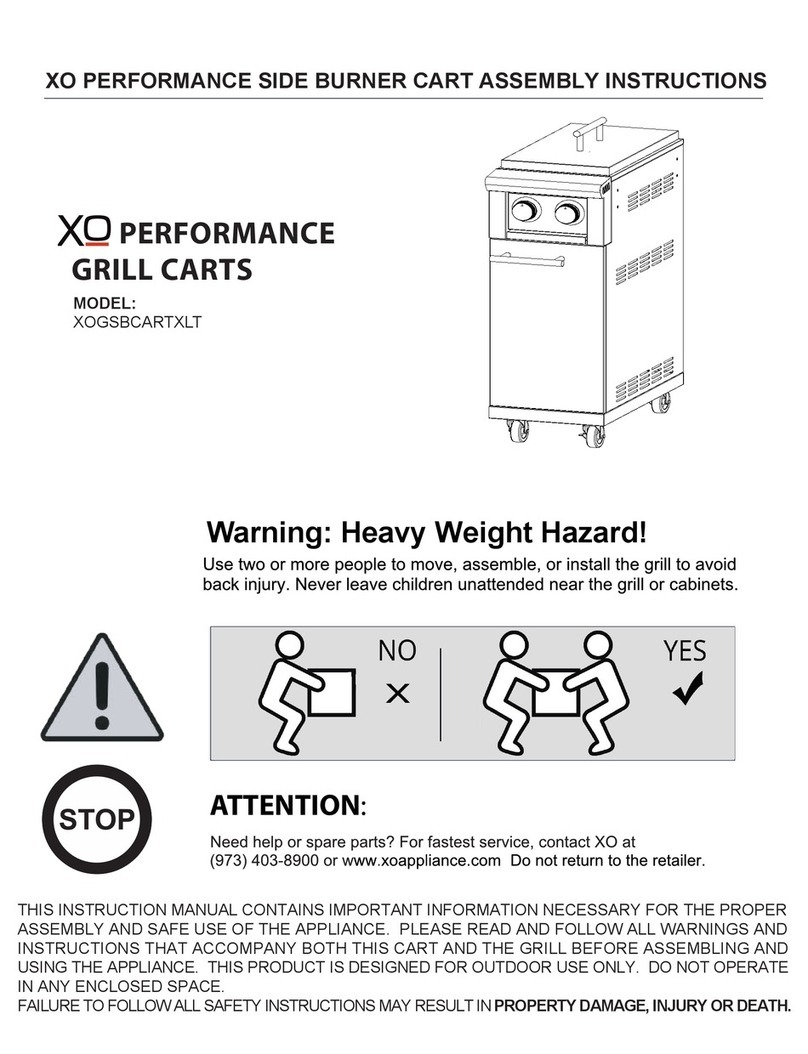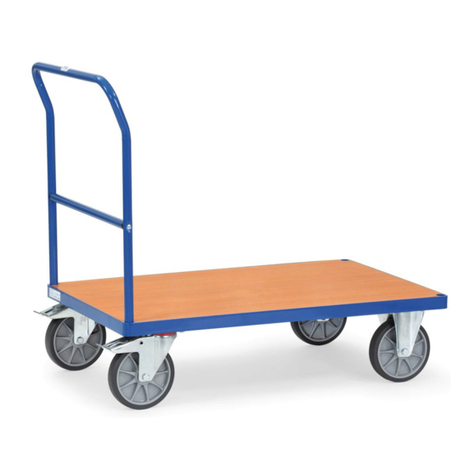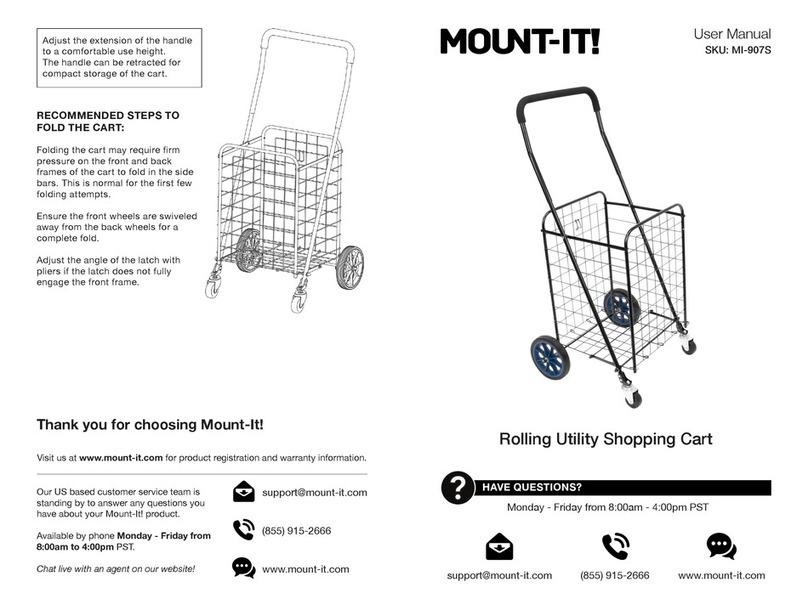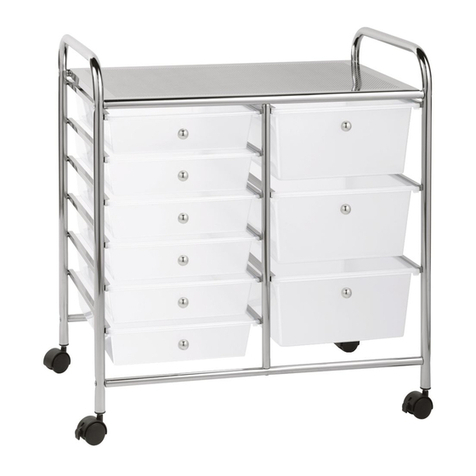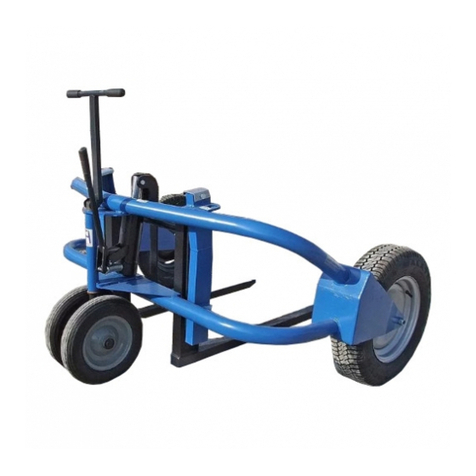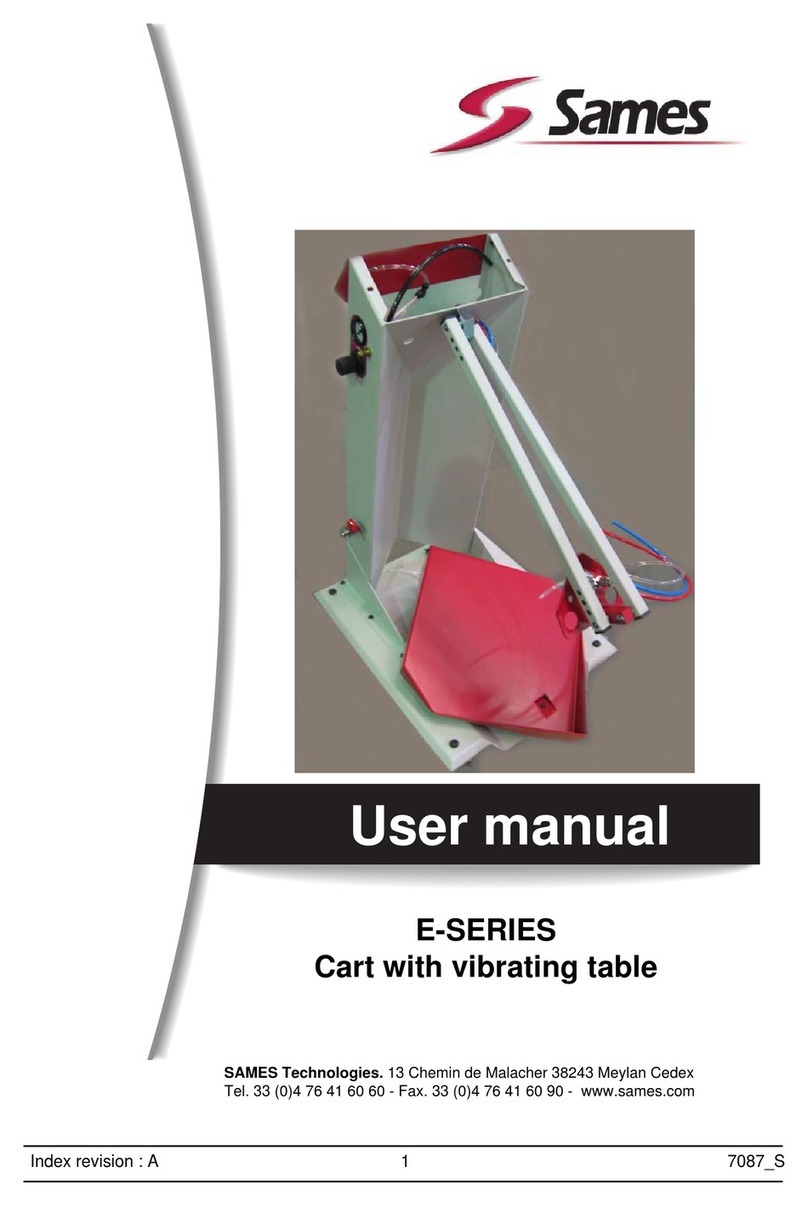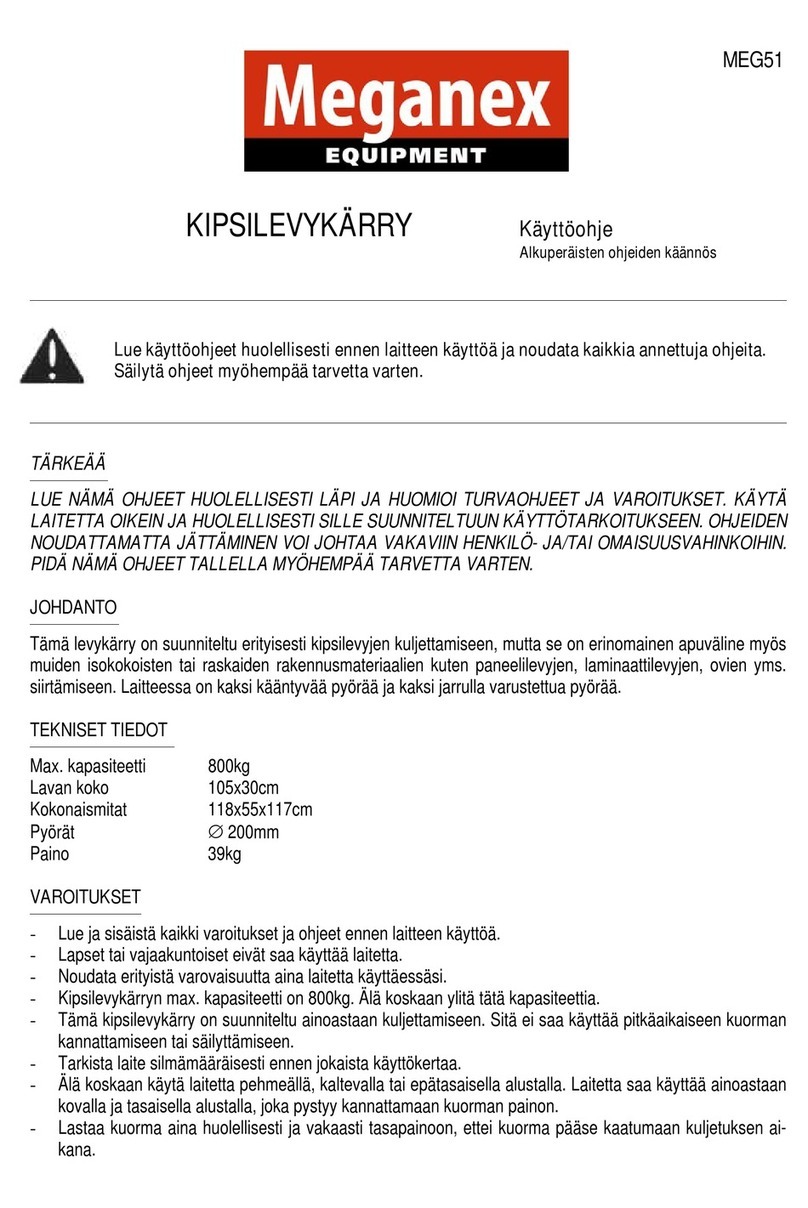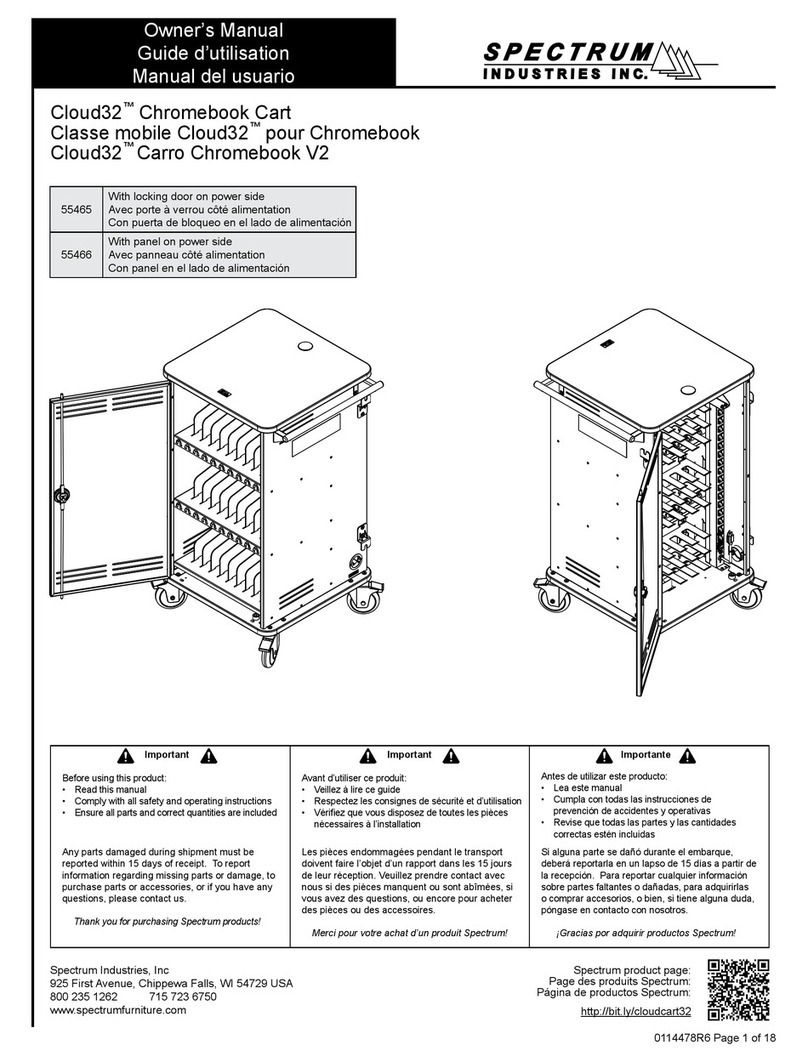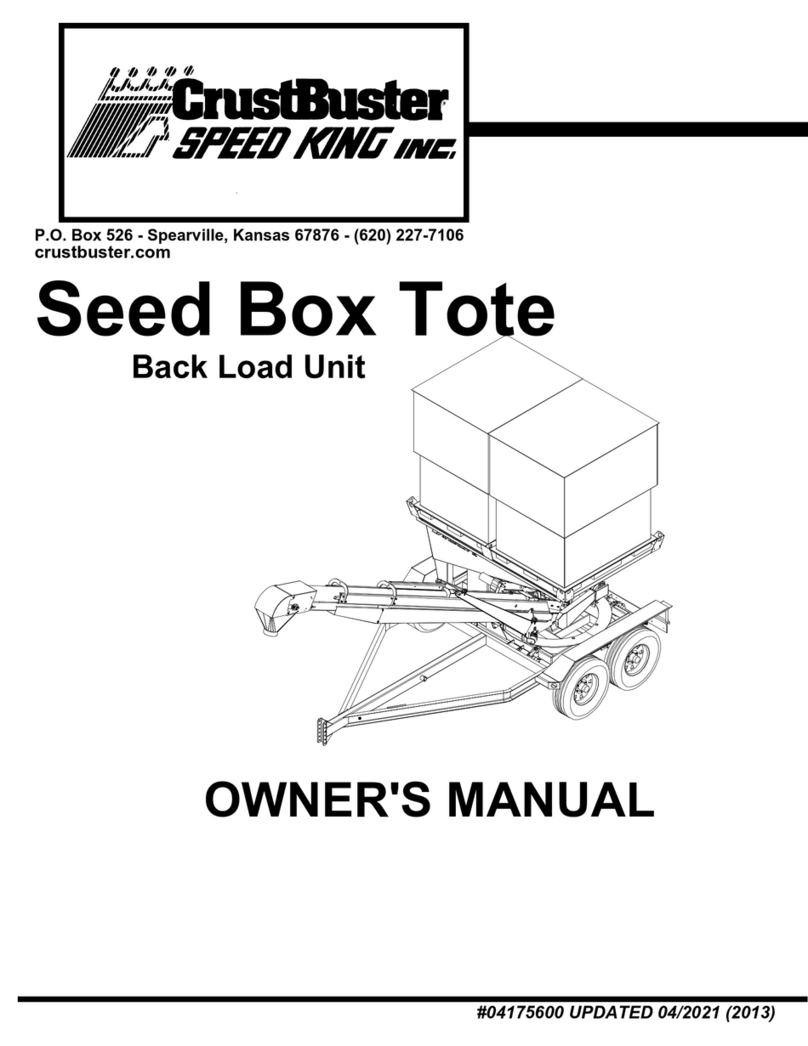EPIC CART E40L User manual

EPIC CART
Owner’s Manual

TABLE OF CONTENTS
SAFETY INFORMATION.......................................................................................1-6
OPERATIONAND SERVICE INFORMATION......................................................7-28
Before initial use..............................................................................................................................7
Key switch, direction selector, battery power display....................................................................8
Accelerator pedal, combination brake and park brake pedal, horn................................................9
Operating the vehicle...................................................................................................................... 10-11
Vehicle cleaning and care, battery replacement...............................................................................12-13
Prolonged Storage............................................................................................................................14
Battery charging...............................................................................................................................15
Troubleshooting, hydrometer...........................................................................................................16
Using A Hydrometer....................................................................................................................... 17
Battery maintenance .......................................................................................................................18-19
Inspection, Specific Gravity Testing.................................................................................................20
Open-Circuit Voltage Test...............................................................................................................21
Watering ...........................................................................................................................................21
Charging ...........................................................................................................................................22
Cleaning........................................................................................................................................... 23
Storage, battery terms explained........................................................................................................23-25
General Maintenance Items List....................................................................................................... 25-27
Common Trouble Shooting List........................................................................................................27-28.
SPECIFCIATION.......................................................................................................................... 29

SAFETY INFORMATION
Owner’s Manual
1
This manual has been designed to assist in maintaining the vehicle in accordance with procedures
developed by the manufacturer. Adherence to these procedures and troubleshooting tips will ensure the
best possible service from the product. To reduce the chance of personal injury or property damage, the
following must be carefully observed:
GENERAL
Good common sense and prudent driving practices do more to prevent accidents and injury than all of the
warnings and instructions combined. The manufacturer strongly suggests that all users and maintenance
personnel read this entire manual paying particular attention to the CAUTIONS and WARNINGS
contained therein.
EPIC CART reserves the right to make design changes without obligation to make these changes on units
previously sold and the information contained in this manual is subject to change without notice.
EPIC CART is not liable for errors in this manual or for incidental or consequential damages that result
from the use of the material in this manual.
These vehicles are designed and manufactured for off-road use. Some communities may permit these
vehicles to be operated on their streets on a limited basis and in accordance with local ordinances.
With electric powered vehicles, be sure that all electrical accessories are grounded directly to the battery (-) post.
Never use the chassis or body as a ground connection.
Refer to GENERAL SPECIFICATIONS for vehicle seating capacity.
Never modify the vehicle in any way that will alter the weight distribution of the vehicle, decrease
its stability, or increase the speed beyond the factory specification. Such modifications can cause
serious personal injury or death.
Vehicles that are capable of higher speeds must limit their speed to no more than the speed of other
vehicles when used in various environment. Additionally, speed should be further moderated by the
environmental conditions, terrain, and common sense.
GENERAL OPERATION
Always:
⚫
Use the vehicle in a responsible manner and maintain the vehicle in safe operating condition.
⚫
Read and observe all warnings and operation instruction labels affixed to the vehicle.
⚫
Follow all safety rules established in the area where the vehicle is being operated.
⚫
Reduce speed to compensate for poor terrain or conditions.
⚫
Apply service brake to control speed on steep grades.

SAFETY INFORMATION
Owner’s Manual
2
⚫
Maintain adequate distance between vehicles.
⚫
Reduce speed in wet areas.
⚫
Use extreme caution when approaching sharp or blind turns.
⚫
Use extreme caution when driving over loose terrain.
⚫
Use extreme caution in areas where pedestrians are present.
MAINTENANCE
Always:
⚫
Maintain the vehicle in accordance with the manufacturer’s periodic service schedule.
⚫
Ensure that repairs are performed by those that are trained and qualified to do so.
⚫
Follow the manufacturer’s maintenance procedures for the vehicle. Be sure to disable the vehicle before
performing any maintenance. Disabling includes removing the key from the key switch and removal of a
battery wire.
⚫
Insulated any tools used within the battery area in order to prevent sparks or battery explosion caused by
shorting the battery terminals or associated wiring. Remove the batteries or cover exposed terminals with
an insulating material.
⚫
Check the polarity of each battery terminal and be sure to rewire the batteries correctly.
⚫
Use specified replacement parts. Never use replacement parts of lesser quality.
⚫
Use recommended tools.
⚫
Determine those tools and procedures not specifically recommended by the manufacturer will not
compromise the safety of personnel nor jeopardize the safe operation of the vehicle.
⚫
Support the vehicle using wheel chocks and jack stands. Never get under a vehicle that is supported by a
jack. Lift the vehicle in accordance with the manufacturer’s instructions.
⚫
Maintain the vehicle in an area away from exposed flame or persons who are smoking.
⚫
Be aware that a vehicle that is not performing as designed is a potential hazard and must not be operated.
⚫
Test driving the vehicle after any repairs or maintenance. All tests must be conducted in a safe area that is
free of both vehicular and pedestrian traffic.
⚫
Replace damaged or missing warning, caution, or information labels.
⚫
Keep complete records of the maintenance history of the vehicle.
Use extreme caution and, if unsure as to the potential for injury, refer the repair or maintenance to a qualified
mechanic.
FOR THE USER
1.GENERALSAFETY PRACTICES
1.1 Introduction
Like other machines, EPIC CART can cause injury if improperly used or maintained. Part II contains
broad safety practices applicable to EPIC CART operations. Before operation, the user shall establish such
additional specific safety practices as may reasonably be required for safe operation.
1.2 Nameplates, Markings, Capacity, and Modifications
1.2.1 The user shall maintain in a legible condition all nameplates, warnings and instructions which are
supplied by the manufacturer.

SAFETY INFORMATION
Owner’s Manual
3
1.2.2 The user shall not perform any modification or addition which affects capacity or safe operation or make
any change not in accordance with the owner’s manual without the manufacturer’s prior written
authorization. Where authorized modifications have been made, the user shall ensure that capacity,
operation, warning and maintenance instruction plates, tags or decals are changed accordingly.
1.3 Changing and Charging Storage Batteries for Electric Personnel and Burden Carriers
1.3.1 The user shall require battery changing and charging facilities and procedures to be in accordance with
appropriate paragraphs.
1.3.2 The user shall periodically inspect facilities and review procedures to be certain that appropriate
paragraphs, are strictly complied with and shall familiarize carrier operators with it.
2. OPERATING SAFETYRULESAND PRACTICES
2.1 General
2.1.1 Safeguard the pedestrians at all times. Do not drive EPIC CART in a manner that would endanger
anyone.
2.1.2 Riding on the EPIC CART by persons other than the operator is authorized only on personnel seat
provided by the manufacturer.
2.1.3 When an EPIC CART is to be left unattended, stop it, apply the parking brake, stop the engine, or turn off
power, turn off the control or ignition circuit, and remove the key if provided. Block the wheels if
machine is on an incline.
2.1.4 Use only approved EPIC CART in hazardous locations, as defined in the appropriate safety standards.
2.1.5 Operators shall not add to, or modify, the EPIC CART.
2.2 Driving
2.2.1 Observe all traffic regulations, including authorized speed limits. Under normal traffic conditions keep to
the right. Maintain a safe distance, based on speed of travel, from a vehicle ahead; and keep the EPIC
CART under control at all times.
2.2.2 Do not pass another vehicle traveling in the same direction at intersections, blind spots, or at other
dangerous locations.
2.2.3 Keep a clear view of the path of travel, observe other traffic and personnel, and maintain a safe
clearance.
2.2.4 Slow down or stop, as conditions dictate, and activate the sound-producing warning device at cross
aisles and when visibility is obstructed at other locations.
2.2.5 Ascend or descend grades slowly.
2.2.6 Under all driving conditions the EPIC CART shall be operated at a speed that will permit it to be brought
to a stop in a safe manner.
2.2.7 Do not indulge in dangerous activities, such as stunt driving or horseplay.
2.2.8 Avoid running over loose objects, potholes, and bumps.
2.2.9 To negotiate turns, reduce speed to improve stability, then turn hand steering wheel or tiller in a smooth,
sweeping motion.
2.2.10 It is recommended that the slope of the road does not exceed 25%, the top of the slope and the slope
must be smooth and transitioned to prevent the bottom of the vehicle and the pavement collision. When the
slope is more than 25%, the signage is recommended.At this point, you must drive the vehicle very carefully.

SAFETY INFORMATION
Owner’s Manual
4
2.3 Loading
2.3.1 At the beginning of each shift during which the EPIC CART will be used, the operator shall check the
EPIC CART condition and inspect the tires, warning devices, lights, battery, speed and directional
controllers, brakes, and steering mechanism. If the EPIC CART is found to be in need of repair or in
any way unsafe, the matter shall be reported immediately to the designated authority and the EPIC
CART shall not be operated until it has been restored to sage operating condition.
2.3.2 Do not make repairs or adjustments unless specifically authorized to do so.
2.3.3 Do not operate an EPIC CART with a leak in the battery.
2.3.4 Do not use open flames for checking electrolyte level in storage battery.
3. MAINTENANCE PRACTICES
3.1 Introduction
3.1.1 Carriers may become hazardous if maintenance is neglected. Therefore, maintenance facilities trained
personnel, and procedures shall be providing such facilities may be on or off the premises.
3.2 Maintenance Procedures
3.2.1 Maintenance and inspection of all EPIC CART shall be performed in conformance with the
manufacturer’s recommendations and the following practices.
(a) A scheduled preventive maintenance, lubrication, and inspection system shall be followed.
(b) Only qualified and authorized personnel shall be permitted to maintain, repair, adjust, and inspect
carriers.
(c) Block chassis before working underneath it.
(d) Operation to check performance of the EPIC CART shall be conducted in an authorized area
where safe clearance exists.
(e) Before commencing operation of the EPIC CART, follow the manufacturer’s instructions and
recommended procedures.
(f) Avoid fire hazards and have fire protection equipment present in the work area. Do not use an
open flame to check level or leakage of battery electrolyte.
(g) Properly ventilate the work area.
(h) Brakes, steering mechanisms, speed and directional control mechanisms, warning devices, lights,
governors, guards, and safety devices shall be inspected regularly and maintained in a safe
operating condition.
(i) Special EPIC CART or devices designed and approved for hazardous area operation shall be
inspected to ensure that maintenance preserves the original approved safe operating features.
(j) Carriers shall be kept in a clean condition to minimize fire hazards and facilitate detection of loose
or defective parts.
(k) Modification and additions which affect capacity and safe machine operation shall not be
performed by the customer or user without manufacturer’s prior written authorization; where
authorized modifications have been made, the user shall ensure that capacity, operation, warning,
and maintenance instruction plates, tags, or decals are changed accordingly.
(l) Care shall be taken to ensure that all replacement parts are interchangeable with the original parts
and of a quality at least equal to that provided in the original equipment.

SAFETY INFORMATION
Owner’s Manual
5
MAINTENANCEAND OPERATIONS
1. GENERALSAFETY PRACTICES
1.1 Introduction
Like other machines, EPIC CART can cause injury if improperly used or maintained. This section contains
broad safety practices recommended for safe EPIC CART operations. Before operation, the controlling party
should establish such additional specific safety practices as may be reasonably required for safe operations.
Experience has shown that EPIC CART which comply with the provisions stated in part II of this standard are
safe when properly operated in accordance with the safety and operation is enhanced when the EPIC CART is
operated within a specific set of operation instructions, safety rules and practices established to meet actual
operating terrain and conditions.
The safety information contained in part II is intended to provide the controlling party with basic safety
information and to encourage the controlling party to implement an EPIC CART safety program.
It is suggested and recommended that Part II be reprinted in the EPIC CART manufacturer’s operation and
service manuals to encourage safe operations and practices at the controlling party’s facility.
1.2 Safety Survey
The controlling party shall perform a safety survey periodically, and as conditions warrant to their premises, to
identify areas where EPIC CART should not be operated and to identify possible hazards.
1.2.1 Wet and Loose Terrain
Wet grassy areas and loose terrain may cause an EPIC CART to lose traction and may affect stability. Wet areas
and loose terrain shall be chained or roped off to prevent EPIC CART operations or be identified by a suitable
warning not to operate EPIC CART in this area due to wet and loose terrain.
1.2.2 Sharp Turns, Blind Corners, Bridge Approaches
Sharp turns, blind spots, bridge approaches and other potentially hazardous areas shall be either chained or
roped off to prevent EPIC CART operations or identified with a suitable warning to the operator of the nature
of the hazard and stating the proper precautions to be taken to avoid the hazard.
2. MAINTENANCE
2.1 Introduction
2.1.1 EPIC CARTs may become hazardous if maintenance is neglected or improperly performed. Therefore,
maintenance facilities, trained personnel, and procedures in accordance with the manufacturer’s
recommendations should be provided by the controlling party.
2.2 Preventive Maintenance
A regularly scheduled inspection and preventive maintenance program in accordance with the manufacturer’s
recommendations should be established.
2.2.1 Personnel
Only qualified, trained, and authorized personnel shall be permitted to inspect, adjust, and maintain EPIC
CART.
2.2.2 Parts and materials
Only manufacturer’s recommended replacement parts and materials shall be used.

SAFETY INFORMATION
Owner’s Manual
6
2.2.3 Ventilation
Maintenance and storage areas shall be properly ventilated to avoid fire hazards in accordance with applicable
fire codes and ordinances.
2.2.4 Maintenance Safety Procedures
All maintenance shall be performed in accordance with the manufacturer’s recommended safety procedures as
outlined in the manufacturer’s operation and service manuals. The following list of recommended safety
procedures are general in nature and in no way supersede the manufacturer’s specific instructions.
2.2.4.1 Following manufacturer’s instructions for immobilizing EPIC CART before beginning any
maintenance.
2.2.4.2 Block chassis before working underneath EPIC CART.
2.2.4.3 Before performing any maintenance on an electric EPIC CART, disable the electrical system in
accordance with the manufacturer’s instructions.
2.2.4.4 Use only properly insulated tools when working on electrically powered EPIC CART or around
batteries.
2.2.4.5 The controlling party shall not perform any modification or addition which affects capacity or safe
operation or make any change not in accordance with owner’s manual without the manufacturer’s
prior written authorization. Where authorized modifications have been made, the controlling party
shall ensure that capacity, operation, warning and maintenance instruction plates, tags or decals are
changed accordingly.
3. OPERATING SAFETY RULESAND PRACTICES
3.1 Operator Qualifications
3.1.1 Only authorized persons shall be allowed to operate EPIC CART, it is recommended that no persons
be allowed to operate EPIC CART except those persons who possess a valid motor vehicle driver’s
license.
3.1.2 The controlling party shall display the operation and safety instructions as recommended by the EPIC
CART manufacturers and the safety rules in a conspicuous place near the EPIC CART rental area or
EPIC CART pick-up area. It is also recommended, as with all motor vehicles, that the warning “Do not
operate EPIC CART when under the influence of alcohol or drugs.” Be posted in a conspicuous
location.

OPERATION INFORMATION
Owner’s Manual
7
OPERATION INSTRUCTIONS
Read all of manual to become thoroughly familiar with this vehicle. Pay particular attention to all Notes,
Cautions and Warnings
Thank you for purchasing this vehicle. Before driving the vehicle, we ask you to spend some time reading this
Owner’s Manual. This guide contains the information that will assist you in maintaining this exceptionally
reliable vehicle.
This vehicle has been designed and manufactured as a “World Vehicle.” Some countries have individual
requirements to comply with their specifications: therefore, some sections may not apply in your country.
Most of the service procedures in this guide can be accomplished using common automotive hand tools.
BEFORE INITIAL USE
Read, understand, and follow the safety label on the dashboard panel. Be sure you understand how to operate the
vehicle, its equipment and how to use it safely. Maintaining superior performance depends to a large extent on
the operator.
Before a new vehicle is put into operation, the items shown in the INITIAL SERVICE CHART must be
performed (Ref Fig.1).
Vehicle batteries must be fully charged before initial use. Check for correct tire inflation. See GENERAL
SPECIFICARIONS.
Determine and record braking distance required to stop vehicle for future brake performance tests.
Remove the protective clear plastic, which protect the seat bottom and back rest during shipping, before placing
the vehicle in service.
ITEM
SERVICEOPERATION
Batteries
Charge batteries
Seats
Remove protective plastic covering
Brakes
Check operation and adjust if necessary
Establish acceptable stopping distance
Tires
Check air pressure (see SPECIFICATIONS)
On Board Charger
-
Fig.1 Initial Service Chart
WARNING To prevent overheating that may cause severe damage to the charger and create the
potential for fire, do not block or obstruct the airways.

OPERATION INFORMATION
Owner’s Manual
8
Fig. 2
The On-Board chargers do come with the vehicle and are located under the seat to prevent damage from the elements.
CONTROLSAND INDICATORS
Vehicle controls and indicators consist of:
1.Hazard Switch Button; 2. Headlights Switch Button.
3. Hi/Low Speed Switch Button 4. Forward/Reverse Switch
5. Ignition Switch 6. Tee Holder
7. Locked Door Panel 8. 7-inch speedometers
9. Combination Switch 10. Steering wheel
KEY SWITCH
Located on the dash panel, this switch enables the basic electrical system of the vehicle to be turned on and off
by turning the key. To prevent inadvertent operation of the vehicle when left unattended, the key should be
turned to the ‘OFF’ position and removed (Ref Fig 2).
DIRECTION SELECTOR
WARNING
To prevent loss of control, do not move direction selector while the vehicle is in motion. Moving the
selector will result in a sudden slowing of the vehicle and the beeping of a warning device.
Located on the dash panel, this switch permits the selection of either ‘FWD’ (forward), ‘REV’(reverse) or neutral
(the position between forward and reverse). Vehicle should be left in neutral when unattended (Ref Fig.2).
BATTERYPOWER DISPLAY
Located on the dash, the speedometer indicates the amount of usable power in the batteries (Ref Fig.2).
it’s a Multifunction speedo meters, integrated with back-up camera

OPERATION INFORMATION
Owner’s Manual
9
ACCELERATOR PEDAL
WARNING Unintentional movement of the accelerator pedal will release the park brake and may cause
the vehicle to move which could result in severe injury or death.
With the key switch ‘ON,’ depressing the accelerator pedal starts the motor. When the pedal is released, the
motor will stop (Ref Fig 3). To stop the vehicle more quickly, depress the service brake.
Acceleration pedal
Fig 3
If key switch is ‘ON” and park brake is set, depressing the accelerator inadvertently will release the park brake
and will cause the vehicle to move which could cause severe injury or death.
Depressing the accelerator pedal will release the park brake if it is engaged. This is a feature to assure the vehicle
is not driven with the park brake engaged. Depressing the accelerator pedal is not the preferred method of
releasing the park brake.
NOTE: Depressing the lower section of the brake pedals the preferred method of releasing the park brake to
assure the longest service life of brake components.
Parking Brake
The brake pedal (Fig 3) does not have parking brake function, EPIC Cart use EMB for parking, its operated by
the magnetic system to control the brake pad.
There is one EMB Switch located on the controller box, the EMB is 3-way switch.
“ON,” stands for the cart at normal running status, when you release the accelerator pedal or stop on the hill, the
EMB will be engage, the cart will stop
“OFF,” stands for the cart park in the garage and whole cart no power consumption, just keep very little current
to the EMB, so cart will not roll down in the garage.
“Manual EMB,” stands for the cart will be able to be towed, the EMB has release.
Brake pedal

OPERATION INFORMATION
Owner’s Manual
10
HORN
The horn is operated by pushing the horn button located on (Ref Fig.4)
Fig. 4
OPERATING THE VEHICLE
CAUTION Improper use of the vehicle or the lack of proper maintenance may result in damage or
decreased performance.
Read and understand the following warnings before attempting to operate the vehicle.
WARNING to reduce the possibility of severe injury or death resulting from loss of vehicle control, the
following warnings must be observed:
When driving vehicle, consider the terrain, traffic conditions and the environmental factors which effect the
terrain and the ability to control the vehicle.
Use extra care and reduced speed when driving on poor surfaces, such as loose dirt, wet grass, gravel, etc.
Stay in designated areas and avoid extremely rough terrain.
Maintain a safe speed when driving downhill. Use service brake to control speed when traveling down an incline.
A sudden stop or change of direction may result in loss of control.
Slow down before and during turns.All turns should be made at reduced speed.

OPERATION INFORMATION
Owner’s Manual
11
WARNING To reduce the possibility of severe injury or death resulting from improper vehicle operation,
the following warnings must be observed:
Refer to GENERALSPECIFICATIONS for seating capacity.
Depressing accelerator pedal will release foot operated park brake and may cause inadvertent vehicle movement.
Turn the key to the ‘OFF’ position whenever the vehicle is parked.
To prevent inadvertent movement when the vehicle is to be left unattended, engage the park brake, move
direction selector to forward position, turn key to ‘OFF’ position and remove key.
Make sure that the direction selector is in correct position before attempting to start the vehicle.
Always bring the vehicle to a complete stop before shifting the direction selector.
Do not take vehicle out of ‘gear’ while in motion (coast).
Check the area behind the vehicle before operating in reverse.
All occupants must be seated. Keep entire body inside vehicle and hold on while vehicle is in motion.
The lifespan, the reliability of the work and the economic efficiency of the use of EPIC Lifted Cart,all depend to a
large extent on the running-in at the initial stage of use. The running-in mileage is 800 kilometers. If conditions
permit, it is best to extend it to 1500Km.
The new cart must go through a running-in before it is officially used. During the running-in period, it should run
at a lower speed. Generally, it cannot be fully loaded and absolutely cannot be operated with overload. The
purpose of running-in is to allow the parts and components to performa stage of running-in, improve its surface
quality and matching accuracy, and avoid early wear and tear of the vehicle.
The following regulations shall be complied with during the integration period
●Avoid fast starting, rapid growth and unnecessary tight braking.
●During the running-in period, the vehicle speed must be strictly controlled within 20Km/h.
●Frequently check whether the battery, electric control, and motor connection wires are loose due to heat.
Frequently check the temperature of the reducer, rear axle, wheel hub and brake drum. If there is overheating
(greater than 60°C), check and eliminate the fault.
●When the running-in mileage reaches 500Km, check the tightness of the steering system, front
suspension and wheel nuts and tighten if necessary. After the running-in period, the user should replace the
lubricating oil and rear axle gear oil during the shifting period.
●During the running-in period, the battery cannot be deeply discharged. After the running-in
period expires, the battery is not allowed to be over-discharged. Over-discharge will quickly
damage the battery.
●If the vehicle mileage is less than 60% of the rated continuous mileage when the vehicle is used for the
first time, please stop using the vehicle and notify the company's after-sales department as soon as possible to
find out the reason. The vehicle is used for more than one month,and the company is no longer responsible for
the compensation of the entire battery pack. Within half a year, due to battery manufacturing quality problems,
the company promises quality warrantyfor damaged batteries.

OPERATION INFORMATION
Owner’s Manual
12
VEHICLE CLEANING AND CARE
VECHILE CLEANING
WARNING To reduce the possibility of severe injury or vehicle damage, read and understand all
instructions supplied by manufacturer of pressure washer.
CAUTION When pressure washing exterior of vehicle, do not use pressure in excess of standard
requirement. To reduce the possibility of cosmetic damage, do not use any abrasive or reactive solvents
It is important that proper techniques and cleaning materials be used. Using excessive water pressure may cause
severe injury to operator or bystander, damage to seals, plastics, seat material, body finish or electrical system.
Do not use pressure in excess of standard requirement to wash exterior of vehicle.
Clean windshield with lots of water and a clean cloth. Minor scratches may be removed using a commercial
plastic polish.
Normal cleaning of vinyl seats and plastic or rubber trim requires the use of a mild soap solution applied with a
sponge or soft brush and wipe with a damp cloth.
The painted surfaces of the vehicle provide attractive appearance and durable protection. Frequent washing with
lukewarm or cold water and mild detergent is required to preserve the painted surface.
Occasional cleaning and waxing with non-abrasive products designed for ‘clear coat’ automotive finishes will
enhance the appearance and durability of the painted surfaces.
Corrosive materials used as fertilizers or for dust control can collect on the underbody of the vehicle. These
materials will cause corrosion of underbody parts unless flushed occasionally with plain water. Thoroughly clean
any areas where mud or other debris can collect. Sediment packed in closed areas should be loosened to ease its
removal, taking care not to chip or otherwise damage paint.
Lubrication maintenance
●The brake fluid of electric vehicles is checked once a month, and if there is a shortage of fuel, it must be
added in time (the lack of fuel will affect driving safety).
●Grease for the front wheel hub, front wheel bearing, brake pedal linkage, and steering system will be refilled
once next year. The oil product model 3# general lithium-based grease. The transmission gear oil is replaced
once a year. Users can choose gear oils with different viscosity levelsaccording to the atmospheric temperature
in the region.
GL-4 90 (used in southern or northern summer) GL-80W/90 (severe cold area or northern winter, -35℃or
below)

OPERATION INFORMATION
Owner’s Manual
13
●Change the gear oil once a year for the rear axle. The oil model is GL-5 90 (used in summer in the south or
north) or GL-5 80W/90 (in severe cold areas or winter in the north, -35℃ or below) gear oil. It is 1.2 liters.
When replacing, first unscrew the oil drain plug, drain the gear oil, clean, and install the oil drain plug, and then
add new gear oil from the filling hole.
Battery Replacement
Remove battery hold downs and cables. Lift batteries out with a commercially available lifting device.
If the batteries have been cleaned and any acid in the battery rack area neutralized as recommended, no corrosion
to the battery racks or surrounding area should be present. Any corrosion found should be immediately removed
with a putty knife and a wire brush. The area should be washed with a solution of sodium bicarbonate (baking
soda) and water and thoroughly dried before priming and painting with a corrosion resistant paint.
The batteries should be placed into the battery racks and the battery hold downs tightened to 45 - 55 in. lbs. (5 - 6
Nm) torque, to prevent movement but not tight enough to cause distortion of the battery cases.
Inspect all wires and terminals. Clean any corrosion from the battery terminals or the wire terminals with a
solution of sodium bicarbonate (baking soda) and brush clean if required.
WARNING To prevent battery explosion that could result in severe personal injury or death, extreme
care must be used with aerosol containers of battery terminal protectant. Insulate the metal container to
prevent the metal can from contacting battery terminals which could result in an explosion.
Use care to connect the battery wires as shown (Ref Fig. 5). Tighten the battery post hardware to 50 70 in. lbs. (6
-8 Nm) torque. Protect the battery terminals and battery wire terminals with a commercially available protective
coating.
Fig.5

OPERATION INFORMATION
Owner’s Manual
14
Prolonged Storage
CAUTION Battery charger, controller and other electronic devices need to be disconnected since they
will contribute to the premature discharge of batteries.
During periods of storage, the batteries will need attention to keep them maintained and prevent discharge.
In high temperatures the chemical reaction is faster, while low temperatures cause the chemical reaction to slow
down. A vehicle that is stored at 90° F (32° C) will lose .002 of specific gravity each day. If a fully charged
battery has a specific gravity of 1.275, and the battery is allowed to sit unused, it will become partially
discharged. When it reaches 1.240, which it will do in less than twenty days, it should be recharged. If a battery
is left in a discharged state, sulfating takes place on and within the plates. This condition is not reversible and
will cause permanent damage to the battery. In order to prevent damage, the battery should be recharged. A
hydrometer can be used to determine the specific gravity and therefore the state of charge of a battery.
In winter conditions, the battery must be fully charged to prevent the possibility of freezing (Ref Fig. 29 on page
23). A fully charged battery will not freeze in temperatures above -75° F (-60° C). Although the chemical
reaction is slowed in cold temperatures, the battery must be stored fully charged, and disconnected from any
circuit that could discharge the battery. For portable chargers, disconnect the charging plug from the vehicle
receptacle. The batteries must be cleaned, and all deposits neutralized and removed from the battery case to
prevent self-discharge. The batteries should be tested or recharged at thirty-day minimum intervals.
BATTERYCHARGING
The battery charger is designed to fully charge the battery set. If the batteries are severely deep cycled, some
automatic battery chargers contain an electronic module
that may not activate, and the battery charger will not function. Automatic chargers will determine the correct
duration of charge to the battery set and will shut off when the battery set is fully charged. Always refer to the
instructions of the specific charger used.
Before charging, the following should be observed:
CAUTION Do not overfill batteries. The charging cycle will expel electrolyte and result in component
damage.
•The electrolyte level in all cells must be at the recommended level and cover the plates.

OPERATION INFORMATION
Owner’s Manual
15
NOTE
Fig. 6
⚫The charging must take place in an area that is well ventilated and capable of removing the hydrogen gas
that is generated by the charging process. Aminimum of five air exchanges per hour is recommended
⚫The charging connector components are in good condition and free from dirt or debris.
⚫The charger connector is fully inserted into the vehicle receptacle.
⚫The charger connector/cord set is protected from damage and is located in an area to prevent injury that may
result from personnel running over or tripping over the cord set.
⚫The charger is automatically turned off during the connect/disconnect cycle and therefore no electrical arc is
generated at the DC plug/receptacle contacts.
In our chargers, there is a jiggle switch inside charger receptacle. The switch is part of the interlock
system that prevents the vehicle from being driven when the charger plug is inserted in the vehicle charging
receptacle. (Fig 7)
Fig. 7

OPERATION INFORMATION
Owner’s Manual
16
TROUBLESHOOTING
In general, troubleshooting will be done for two distinct reasons. First, a battery that performs
poorly and is outside of the manufacturer’s specification should be identified in order to replace it
under the terms of the manufacturer’s warranty. Different manufacturers have different
requirements. Consult the battery manufacturer or a manufacturer representative for specific
requirements.
The second reason is to determine why a particular vehicle does not perform adequately.
Performance problems may result in a vehicle that runs slowly or in a vehicle that is unable to
operate for the time required.
A new battery must mature before it will develop its maximum capacity. Maturing may take up to
100 charge/discharge cycles. After the maturing phase, the older a battery gets, the lower the
capacity. The only way
to determine the capacity of a battery is to perform a load test using a discharge machine following
manufacturer’s recommendations.
A cost-effective way to identify a poorly performing battery is to use a hydrometer to identify a
battery in a set with a lower-than-normal specific gravity. Once the particular cell or cells that are
the problem are identified, the suspect battery can be removed and replaced. At this point there is
nothing that can be done to salvage the battery; however, the individual battery should be replaced
with a good battery of the same brand, type, and approximate age.
Hydrometer
A hydrometer is used to test the state of charge of a battery cell (Ref Fig. 8). This is performed by
measuring the density of the electrolyte, which is accomplished by measuring the specific gravity
of the electrolyte. The greater the concentration of sulfuric acid, the denser the electrolyte
becomes. The higher the density, the higher the state of charge.
WARNING To prevent battery explosion that could result in severe personal injury or
death, neverinsert a metal thermometer into a battery. Use a hydrometer with a built-in
thermometer

OPERATION INFORMATION
Owner’s Manual
17
NOTE
Fig.8
Specific gravity is the measurement of a liquid that is compared to a baseline. The baseline is water which is
assigned a base number of 1.000. The concentration of sulfuric acid to water in a new golf car battery is 1.280
which means that the electrolyte weighs 1.280 times the weight of the same volume of water. A fully charged
battery will test at 1.275 -1.280 while a discharged battery will read in the 1.140 range.
Do not perform a hydrometer test on a battery that has just been watered. The battery must go through at
least one charge and discharge cycle in order to permit the water to adequately mix with the electrolyte.
The temperature of the electrolyte is important since the hydrometer reading must be corrected to 80° F (27° C).
High quality hydrometers are equipped with an internal thermometer that will measure the temperature of the
electrolyte and will include a conversion scale to correct the float reading. It is important to recognize that the
electrolyte temperature is significantly different from the ambient temperature if the vehicle has been operated.
UsingA Hydrometer
1. Draw electrolyte into the hydrometer several times to permit the thermometer to adjust to the electrolyte
temperature and note the reading. Examine the color of the electrolyte. A brown or gray coloration indicates a
problem with the battery and is a sign that the battery is nearing the end of its life.
2. Draw the minimum quantity of electrolyte into the hydrometer to permit the float to float freely without
contacting the top or bottom of the cylinder.

OPERATION INFORMATION
Owner’s Manual
18
3. Hold the hydrometer in a vertical position at eye level and note the reading where the electrolyte meets the
scale on the float.
4. ρ25℃= ρt +0.0007(t-25)
ρ25℃——25℃electrolyte specific gravity ;ρ
t ——t℃electrolyte specific gravity.
5. Test each cell and note the readings (corrected to 80° Fig. 30 Hydrometer F or 27° C). A variation of fifty
points between any two cell readings (example 1.250 -1.200) indicates a problem with the low reading cell(s).
As a battery ages the specific gravity of the electrolyte will decrease at full charge. This is not a reason to replace
the battery, providing all cells are within fifty points of each other.
Since the hydrometer test is in response to a vehicle exhibiting a performance problem, the vehicle should be
recharged and the test repeated. If the results indicate a weak cell, the battery or batteries should be removed and
replaced with a good battery of the same brand, type, and approximate age.
BATTERY MAINTENANCE
Our experience shows that the key to achieving optimum performance and long life is a solid battery
maintenance program using the simple procedures
outlined here.
Equipment:
We recommend the following equipment for use in battery care and maintenance:
Recommended Equipment:
◆
◆Wrench
◆Distilled Water
◆Voltmeter
◆Hydrometer
◆Thermometer
◆Post Cleaner
◆Baking Soda
◆Vaseline
◆Goggles & Gloves
CAUTION:Always wear protective clothing, gloves, and goggles
When handling batteries, electrolyte, and charging your battery.
This manual suits for next models
2
Table of contents
